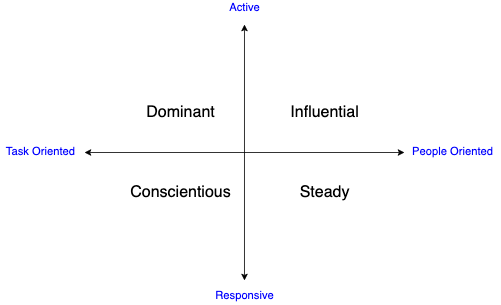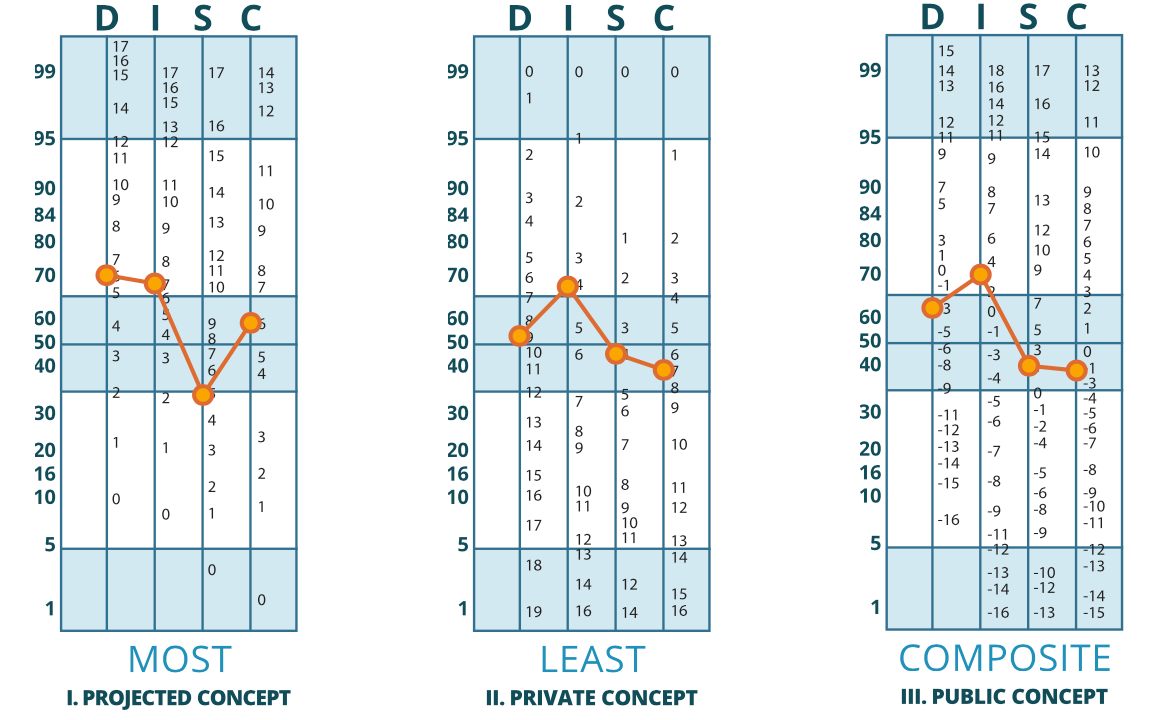Explore your personality with DISC

Imagine that by answering some questions you gain the following benefits:
- Raise your self-awareness
- Improve your teamwork
- Resolve conflict more productively
- Develop stronger communication skills
- Manage more effectively
The DISC assessment attempts to meet this promise. I wouldn't blame you if you were skeptical right now, but don't trash it just yet.
So what's the DISC assessment? Based on specific questions and how you answer them, it tries to predict your primary personality style. Your style determines how you like to work, how you like to communicate, what you excel at, what motivates you, and what you need to look out for.
I recently participated in a DISC course and took the assessment. Spoiler alert, it was pretty accurate. In my opinion, the main benefit is in the wealth of knowledge you gain about different personalities.
A little tangent.
The idea that people can be placed into boxes exactly identifying them is absurd. But that is not the aim of DISC and the creators clearly understand that. In fact, they mention "it is important to remember these patterns only cover observable tendencies" and that "there are many other factors that affect your behaviour". They encourage you to think for yourself and to "cross out what you disagree with and underline what you agree with".
DISC is not the end-all-be-all. It isn't definite and to my knowledge isn't backed by research outside what was done by the creators. Learn about it then make your judgement. It's completely up to you.
DISC Styles
DISC is an acronym that stands for the four main personality styles identified by Dr. William Marston, the founder of DISC:
- Dominant
- Influential
- Steady
- Conscientious
He explains that these traits are present in all people to varying degrees. They emerge as a result of a combination of various factors. People are either task-oriented or people-oriented. They respond to their environment in two ways, either they are active or responsive. Using a scale of these factors, people are placed into one of the four DISC styles.

Let's summarize each style. The source of this information is the same website you can take the assessment, DISC Profile. We'll just be scratching the surface here. Just enough to get a general idea of the differences. I recommend you take the assessment if you'd like the detailed version. They send a PDF to your email with your results and some great information.
An important note is that all styles are valuable. One is not better than the other. People have the ability to shift between each style depending on the environment and their primary style can change throughout their lifetime. I highly recommend you continuously reference the image above as you go through each style.
Dominant
Key to motivation: Challenge, winning, authority
Fears: Loss of control, being taken advantage of
- Direct
- Demanding of self and others
- Thrives under challenging circumstances
Influential
Key To motivation: Recognition, relationships
Fears: Social rejection, being ignored, being controlled
- Friendly, persuasive
- Impulsive
- Thrives on social interactions
Steady
Key to motivation: Appreciation, cooperation
Fears: Loss of stability, offending others
- Calm, passive
- Even-tempered, patient
- Thrives in a relaxed environment
Conscientious
Key to motivation: Security, quality work, gaining knowledge
Fears: Criticism, being wrong
- Precise, cautious
- Diplomatic
- Thrives in a predictable environment
My DISC Profile
Of course, I was very interested in my profile. I also wanted to gauge the accuracy of the assessment.
The results provide 3 key pieces of information. First, your primary style, which is the style that is dominant to your personality. Second, they describe your Most, Least, and Composite graphs, which are graphs representing your personality in different lights. Finally, they provide your representative pattern, which is an analysis of how the four styles combine and influence each other. This representative pattern is then used to dissect your observable traits, your motivators, your growth potential, and your ideal work setting.
Primary Style
My primary style was determined as Influential. I's are identified as people-oriented and task-oriented people.
People with the Influential style like to create an environment of motivation and to align others to accomplish goals. While I generally agree, I sometimes like to work alone too. Mostly when it comes to side projects. It states they can be assertive but are considerate of others. Sounds right (I try to at least). They like working in an environment free of control. That's true, but I also like order and following the rules. They are at ease with strangers in both work and social situations. I consider myself more at ease at work. Lastly, their key to motivation is recognition. Not sure who doesn't want recognition for their work but I wouldn't say that's my primary intent or motivator. Making a positive difference in myself and others is my primary intent. My urge for constant improvement is my motivator. If that comes with recognition, that's a side effect in my opinion.
I consider the assessment mostly accurate here. But I can see myself floating across all styles. I can recall situations that brought a certain style more to the forefront. Interestingly, while I was reviewing the results I kept thinking of my style in and out of work and how it differed.
Least, Most, and Composite Graphs
Next up, the results show three graphs with the four styles listed on a scale.
The Most graph is your projected style, what you like to portray to others. The Least is your private style when you're not at work or in social situations. The Composite is a blend of both, representing more clearly how others perceive you. The assessment recommends you use the Composite graph when interpreting further results. Here are my graphs.

From my Most graph compared to my Least, they claim that within my daily activities (or what I like to portray) I see the need to:
- Be more assertive, push for results, and act decisively
- Follow the rules, concentrate on details, seek accuracy and precision
Both these points are spot on. I am by nature an indecisive person outside of work (those 10-page restaurant menus aren't helping). Knowing this about myself and wanting to improve, I try to act decisively in all aspects of life. Similarly, I like to follow the rules as I said before. Finally, my job as a Quality Engineer means I need to concentrate on the details and ensure accuracy. However, I focus on the details when I'm an individual contributor at work. As a People Manager or a Lead, I will only go to the details if I see the need to.
I'm not 100% sure, but I guess my Composite graph being similar to my Least graph means people perceive me as my true self. That's good!
Representative Pattern
The representative pattern matches closely with your Composite and Least graphs. Its goal is to help you learn about yourself and others in a way that maximizes your abilities. My representative pattern was determined as a Persuader.
Observable Traits
A Persuader is viewed as positive, persuasive, goal-minded, and independent. Spot on for me here. They thrive on taking risks. That doesn't describe me. They're friendly but argumentative. True. When a Persuader starts talking, words pop into their head and immediately out their mouth. Mostly true for me. Their basic empathy for people overrides their desire to win. Honestly, this depends on the situation and topic. Maybe that's why I scored high in the D style.
Internal Motivators
Persuaders are self-reliant, outgoing, and uninhibited. Sounds right. To be successful, they see the need to be self-starters who can convince people their way is right. True. They see the need to control events and people. If they were talking about my older self, they'd be right. I learned the hard way this doesn't serve me or others positively. There are times when I will take control, and that's when I see issues are not being resolved in a timely manner. Persuaders prefer to deal with the big picture. Sometimes true for me, usually when in a leadership position at work. They like to be center stage. Not true for me. I force myself in some cases to be center stage but I actually don't like it.
Potential for Growth
I was disappointed with the information the report had in this section. It was minimal. Their suggestions boiled down to being a better listener and curbing stubbornness. Both I agree with. I scanned through the assessment again and noted down the points I'd like to improve. I don't currently have the complete answers for how, so I'll jot down some quick thoughts.
- Friendly but argumentative - Improve conflict handling skills with better communication techniques and keep focus on results. Listen more. Know when to stop arguing and reach a win-win.
- Words pop into their head and immediately out their mouth - Practice thinking before speaking. Work on keeping emotions in check and reducing knee-jerk reactions.
- Independent - While this isn't necessarily bad, keeping in mind the importance of teamwork could help me and others achieve greater things. I can also be more open to suggestions.
- Friendliness can fade under pressure - Be mindful of my tone when under pressure. Better control of emotions.
This is the heart of the DISC assessment for me. I need to reflect more on this section and come up with a proper plan for improvement.
Ideal Work Setting
Because of their independence, Persuaders don't like to work in environments with tight supervision. True for me. They need to know the "why" behind everything. Mostly true for me. They need to know what they are being held accountable for. Not really me. I usually set my own goals and standards. They respond well to democratic managers who are willing to bounce ideas back and forth. Check.
Final Thoughts
Did the assessment deliver on its promise? It definitely raised my self awareness but the other points need more time. I can see how DISC can provide all the benefits it claims though. In my opinion, those benefits increase as more people take the assessment.
I thoroughly enjoyed the assessment and the information the final PDF had. My immediate next steps are to continue studying DISC and put my learnings to practice. I look forward to taking the assessment again in a few years to compare against my current results.